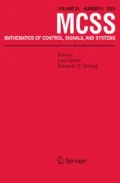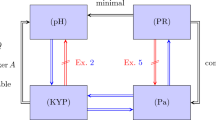Abstract
The modeling framework of port-Hamiltonian systems is systematically extended to linear constrained dynamical systems (descriptor systems, differential-algebraic equations) of arbitrary index and with time-varying constraints. A new algebraically and geometrically defined system structure is derived. It is shown that this structure is invariant under equivalence transformations, and that it is adequate also for the modeling of high-index descriptor systems. The regularization procedure for descriptor systems to make them suitable for simulation and control is modified to preserve the port-Hamiltonian form. The relevance of the new structure is demonstrated with several examples.
Similar content being viewed by others
References
Bals J, Hofer G, Pfeiffer A, Schallert C (2005) Virtual iron bird—a multidisciplinary modelling and simulation platform for new aircraft system architectures. In: Deutscher Luft-und Raumfahrtkongress, Friedrichshafen, Germany
Beattie C, Gugercin S (2011) Structure-preserving model reduction for nonlinear port-Hamiltonian systems. In: 50th IEEE conference on decision and control and European control conference (CDC-ECC), 2011. IEEE, pp 6564–6569
Binder A, Mehrmann V, Miedlar A, Schulze P (2015) A Matlab toolbox for the regularization of descriptor systems arising from generalized realization procedures. Preprint 24–2015, Institut für Mathematik, TU Berlin
Breedveld PC (2008) Modeling and simulation of dynamic systems using bond graphs. EOLSS Publishers Co. Ltd./UNESCO, Oxford, pp 128–173
Brenan KE, Campbell SL, Petzold LR (1996) Numerical solution of initial-value problems in differential algebraic equations, 2nd edn. SIAM Publications, Philadelphia
Bunse-Gerstner A, Byers R, Mehrmann V, Nichols NK (1999) Feedback design for regularizing descriptor systems. Linear Algebra Appl 299:119–151
Byers R, Kunkel P, Mehrmann V (1997) Regularization of linear descriptor systems with variable coefficients. SIAM J Control Optim 35(1):117–133
Byrnes CI, Isidori A, Willems JC (1991) Passivity, feedback equivalence, and the global stabilization of minimum phase nonlinear systems. IEEE Trans Autom Control 36:1228–1240
Campbell SL (1987) A general form for solvable linear time varying singular systems of differential equations. SIAM J Math Anal 18:1101–1115
Campbell SL (1995) Linearization of DAEs along trajectories. Z Angew Math Phys 46:70–84
Campbell SL, Kunkel P, Mehrmann V (2012) Regularization of linear and nonlinear descriptor systems. In: Biegler LT, Campbell SL, Mehrmann V (eds) Control and optimization with differential-algebraic constraints, advances in control and design, chapter 2. SIAM Publications, Philadelphia, pp 17–36
Couenne F, Jallut C, Maschke BM, Tayakout M, Breedveld PC (2008) Bond graph for dynamic modelling in chemical engineering. Chem Eng Process 47:1994–2003
Dai L (1989) Singular control systems, volume 118 of Lecture Notes in Control and Inform. Sci. Springer-Verlag, Berlin/Heidelberg
Dirac PAM (1950) Generalized Hamiltonian dynamics. Can J Math 2:129–148
Egger H, Kugler T (2018) Damped wave systems on networks: exponential stability and uniform approximations. Numer Math 138(4):839–867
Egger H, Kugler T, Liljegren-Sailer B, Marheineke N, Mehrmann V (2018) On structure preserving model reduction for damped wave propagation in transport networks. SIAM J Sci Comput 40:A331–A365
Eich-Soellner E, Führer C (1998) Numerical methods in multibody dynamics. Teubner, Stuttgart
Freund RW (2011) The SPRIM algorithm for structure-preserving order reduction of general RLC circuits. In: Model reduction for circuit simulation. Springer, pp 25–52
Fujimoto K, Sugie T (2001) Canonical transformation and stabilization of generalized Hamiltonian systems. Syst Control Lett 42(3):217–227
Gillis N, Mehrmann V, Sharma P (2018) Computing the nearest stable matrix pairs. Numer Linear Algebra Appl 25:e2153
Golo G, van der Schaft AJ, Breedveld PC, Maschke BM (2003) Hamiltonian formulation of bond graphs. In: Rantzer A, Johansson R (eds) Nonlinear and hybrid systems in automotive control. Springer, Heidelberg, pp 351–372
Gugercin S, Polyuga RV, Beattie C, van der Schaft AJ (2012) Structure-preserving tangential interpolation for model reduction of port-Hamiltonian systems. Automatica 48:1963–1974
Hiller M, Hirsch K (2006) Multibody system dynamics and mechatronics. Z Angew Math Mech 86(2):87–109
Hinrichsen D, Pritchard AJ (2005) Mathematical system theory I. Modelling, state space analysis, stability and robustness. Springer, New York
Hou M (1994) A three-link planar manipulator model. Sicherheitstechnische Regelungs- und Meßtechnik. Bergische Universität-GH Wuppertal, Wuppertal
Hou M, Müller PC (1994) \(LQ\) and tracking control of descriptor systems with application to constrained manipulator. Technical report, Sicherheitstechnische Regelungs- und Meßtechnik, Universität Wuppertal, Gauß-Straße, Wuppertal 1, Germany
Jacob B, Zwart H (2012) Linear port-Hamiltonian systems on infinite-dimensional spaces. Operator theory: advances and applications, vol 223. Springer, Berlin
Kleijn C (2013)20-sim 4C 2.1 Reference manual. Controlab Products B.V
Kunkel P, Mehrmann V (2001) Analysis of over-and underdetermined nonlinear differential-algebraic systems with application to nonlinear control problems. Math Control Signals Syst 14:233–256
Kunkel P, Mehrmann V (2006) Differential-algebraic equations. Analysis and numerical solution. EMS Publishing House, Zürich
Kunkel P, Mehrmann V, Rath W (2001) Analysis and numerical solution of control problems in descriptor form. Math Control Signals Syst 14:29–61
Kunkel P, Mehrmann V, Scholz L (2014) Self-adjoint differential-algebraic equations. Math Control Signals Syst 26:47–76
Lamour R, März R, Tischendorf C (2013) Differential-algebraic equations: a projector based analysis. Springer, Berlin
Maschke BM, van der Schaft AJ, Breedveld PC (1992) An intrinsic Hamiltonian formulation of network dynamics: non-standard Poisson structures and gyrators. J Frankl Inst 329:923–966
Mehl C, Mehrmann V, Wojtylak M (2018) Linear algebra properties of dissipative Hamiltonian descriptor systems. SIAM J Matrix Anal Appl. To appear
Mehrmann V, Schröder C (2011) Nonlinear eigenvalue and frequency response problems in industrial practice. J Math Ind 1:18
Ortega R, van der Schaft AJ, Mareels Y, Maschke BM (2001) Putting energy back in control. Control Syst Mag 21:18–33
Polderman JW, Willems JC (1998) Introduction to mathematical systems theory: a behavioural approach. Springer, New York
Polyuga RV, van der Schaft AJ (2010) Structure preserving model reduction of port-Hamiltonian systems by moment matching at infinity. Automatica 46:665–672
Schiehlen W (1993) Advanced multibody system dynamics. Kluwer Academic Publishers, Stuttgart
Schlacher K, Kugi A (2001) Automatic control of mechatronic systems. Int J Appl Math Comput Sci 11(1):131–164
Scholz L (2017) Condensed forms for linear port-Hamiltonian descriptor systems. Preprint 09–2017. Institut für Mathematik, TU Berlin
Trautenberg W Simpack 8.9. Manual, INTEC GmbH, Angelrieder Feld 13, 82234 Wessling
van der Schaft AJ (2004) Port-Hamiltonian systems: network modeling and control of nonlinear physical systems. In: Advanced dynamics and control of structures and machines, CISM courses and lectures, Vol. 444. Springer, New York, NY
van der Schaft AJ (2006) Port-Hamiltonian systems: an introductory survey. In: Verona JL, Sanz-Sole M, Verdura J (eds) Proceedings of the international congress of mathematicians, vol. III, invited lectures, Madrid, Spain, pp 1339–1365
van der Schaft AJ (2013) Port-Hamiltonian differential-algebraic systems. In: Surveys in differential-algebraic equations I. Springer, pp 173–226
van der Schaft AJ, Maschke BM (2002) Hamiltonian formulation of distributed-parameter systems with boundary energy flow. J Geom Phys 42:166–194
Acknowledgements
We acknowledge many interesting discussions with Robert Altmann and Philipp Schulze from TU Berlin and Arjan Van der Schaft from RU Groningen. We also thank two anonymous reviewers for helpful comments to improve the presentation. The first author has been supported by Einstein Foundation Berlin, through an Einstein Visiting Fellowship. The second author has been supported by Deutsche Forschungsgemeinschaft for Research support via Project A02 in CRC 1029 TurbIn, and project B03 in CRC-TR154 as well as by Einstein Foundation Berlin within the Einstein Center ECMath.
Author information
Authors and Affiliations
Corresponding author
Additional information
Publisher's Note
Springer Nature remains neutral with regard to jurisdictional claims in published maps and institutional affiliations.
Christopher Beattie: Supported by Einstein Foundation Berlin, through an Einstein Visiting Fellowship. Volker Mehrmann: Supported by Einstein Foundation Berlin via the Einstein Center ECMath and by Deutsche Forschungsgemeinschaft via Project A02 within CRC 1029 ’TurbIn’. Hongguo Xu : Partially supported by Alexander von Humboldt Foundation and by Deutsche Forschungsgemeinschaft, through the DFG Research Center Matheon Mathematics for Key Technologies in Berlin.
Rights and permissions
About this article
Cite this article
Beattie, C., Mehrmann, V., Xu, H. et al. Linear port-Hamiltonian descriptor systems. Math. Control Signals Syst. 30, 17 (2018). https://doi.org/10.1007/s00498-018-0223-3
Received:
Accepted:
Published:
DOI: https://doi.org/10.1007/s00498-018-0223-3
Keywords
- Port-Hamiltonian system
- Descriptor system
- Differential-algebraic equation
- Passivity
- Stability
- System transformation
- Differentiation index
- Strangeness-index
- Skew-adjoint operator




